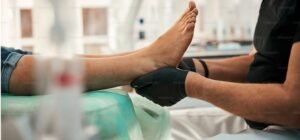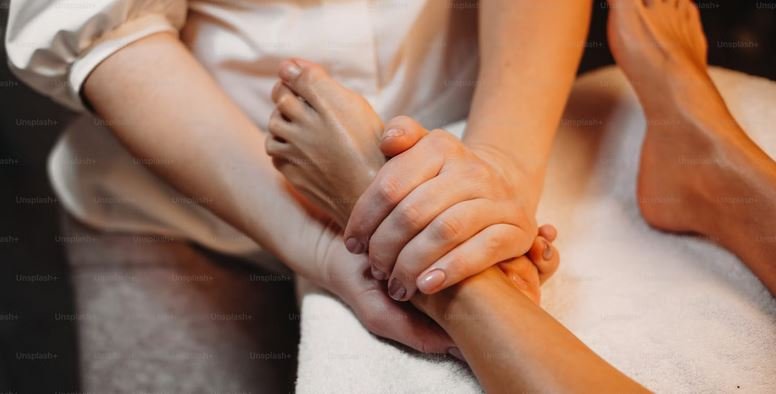Have you ever wondered about Chinese foot massage and its growing popularity despite hearing it might be painful? This blog post is here to demystify the practice for you. We’ll delve into what Chinese foot massage is, its roots in Traditional Chinese Medicine, and the reasons behind its intensity. Alongside, we’ll highlight the numerous benefits it promises, from alleviating pain to promoting better sleep and improving blood circulation. For those who might be hesitant about the discomfort, we’ll also introduce some soothing alternatives. Join us on this enlightening journey to discover how this ancient therapy could be a key to unlocking a more balanced and healthier lifestyle.
Chinese foot massage can be painful due to the techniques used, such as pressure, kneading, and pounding, which stimulate pressure points and release blocked energy. However, the pain may be beneficial in promoting healing and restoring balance within the body.
Understanding Chinese Foot Massage
Table of Contents
Chinese foot massage, an integral part of Traditional Chinese Medicine (TCM), is gaining popularity worldwide for its unique approach to promoting health and wellness.
Origins and Principles
At its core, Chinese foot massage is more than just a soothing therapy; it’s a healing practice with roots in ancient Chinese traditions. This method is built on the principle that certain areas on the feet are linked to different organs and systems in the body. By massaging these specific points, known as reflex points, the therapy aims to enhance energy flow, or “Qi,” and restore balance within the body.
The Reflexology Map
The foundation of Chinese foot massage lies in the reflexology map of the feet. This map outlines how each part of the foot corresponds to an organ or area of the body. For example, the tips of the toes reflect the head, the balls of the feet mirror the heart and chest, and the heels correspond to the lower back and intestines. Understanding this connection allows practitioners to target specific health issues through foot massage.
Techniques and Practices
Chinese foot massage involves a variety of techniques, including pressing, kneading, and sometimes tapping. These methods are designed to stimulate the reflex points and encourage the release of blockages in the body’s energy pathways. The process not only aims to improve physical health but also to bring about a sense of relaxation and well-being.
How Chinese Foot Massage Works

Chinese foot massage, deeply rooted in Traditional Chinese Medicine (TCM), is a therapeutic practice believed to enhance well-being by stimulating specific points on the feet. Let’s explore how this ancient technique works and its basis in reflexology and energy flow.
The Theory of Reflexology
Reflexology is the cornerstone of Chinese foot massage. It suggests that the feet are mirrors to the rest of the body, with specific areas corresponding to different organs and systems. The theory posits that applying pressure to these reflex points can influence the health of the associated body parts, promoting healing and balance.
Energy Flow and Qi
In TCM, the concept of “Qi” (pronounced “chee”) is fundamental. Qi is the life force or energy that flows through the body’s pathways, known as meridians. Chinese foot massage aims to remove blockages in these pathways, allowing Qi to flow freely, which is essential for health and vitality. When Qi is blocked, it can lead to discomfort or illness, and stimulating the feet’s reflex points is believed to clear these blockages, restoring the body’s balance and natural healing abilities.
The Practice and Its Techniques
Practitioners of Chinese foot massage use a variety of techniques to activate the reflex points. These include applying pressure with thumbs, fingers, or a wooden stick, as well as kneading, rubbing, and tapping the feet. The intensity of the massage can vary, and while it may sometimes be uncomfortable, this discomfort is seen as a sign of the body’s healing process being activated.
Skepticism and Scientific View
It’s important to acknowledge that the effectiveness of reflexology and the concept of Qi are topics of debate in the scientific community. While many individuals report positive outcomes from Chinese foot massage, such as relaxation and improved well-being, the scientific evidence supporting the specific claims of reflexology is limited. Nevertheless, the practice continues to be popular as a complementary therapy, valued for its potential to relieve stress and promote relaxation.
Why Chinese Foot Massage Can Be Painful
Chinese foot massage, while known for its numerous benefits, is often associated with a certain level of discomfort or pain. Let’s delve into the reasons behind this pain and understand its significance in the healing process.
Techniques That Trigger Discomfort
The core techniques used in Chinese foot massage, such as deep pressure, kneading, and sometimes even pounding, are designed to stimulate the reflex points on the feet. These techniques can be intense because they aim to release blocked energy and restore the flow of Qi. When a practitioner applies pressure to areas that correspond to imbalances in the body, it can result in sensations ranging from mild discomfort to significant pain, depending on the individual’s sensitivity and the extent of the blockage.
Stimulating Pressure Points
Each pressure point on the foot is believed to be linked to an organ or part of the body. When these points are stimulated, especially if there’s an underlying issue or blockage, the reaction can be painful. This pain is often interpreted as a sign that the massage is effectively addressing problem areas, with the discomfort being a part of the healing process.
Releasing Blocked Energy
According to Traditional Chinese Medicine, pain during a foot massage can indicate the presence of blocked energy pathways within the body. The discomfort experienced is seen as a positive sign that these blockages are being cleared, facilitating better energy flow and contributing to the body’s natural healing processes.
Individual Sensitivity
It’s important to note that everyone’s pain threshold and sensitivity to massage techniques vary. Some individuals might find certain levels of pressure relaxing, while others may perceive the same pressure as painful. Communication with the massage therapist is key to ensuring the massage is effective yet comfortable.
Read: Why Do My Feet Hurt After a Foot Massage?
Benefits of Chinese Foot Massage
Despite the discomfort it may sometimes cause, Chinese foot massage offers a range of potential benefits that contribute to overall health and well-being. Let’s explore these advantages and understand why many people incorporate this practice into their wellness routines.
Pain Relief and Relaxation
One of the most immediate benefits of Chinese foot massage is the relief from physical pain and the deep relaxation it can induce. The massage techniques, even though they might be intense, help to soothe tired feet, reduce muscle tension, and alleviate aches in the body. This relaxation effect can also extend to the mind, reducing stress and promoting a sense of calm.
Improved Sleep Patterns
Regular sessions of Chinese foot massage have been linked to better sleep quality. By reducing stress levels and promoting relaxation, this massage technique can help individuals find it easier to fall asleep and stay asleep, leading to more restful and rejuvenating nights.
Enhanced Circulation
Stimulating the reflex points on the feet is believed to improve blood circulation throughout the body. Better circulation means more oxygen and nutrients being delivered to cells, which can enhance healing and overall health.
Boosted Digestive Health
Some reflex points in the foot are associated with the body’s digestive system. By targeting these areas, Chinese foot massage may help stimulate digestion, alleviate common issues like bloating and constipation, and promote a healthy digestive process.
Detoxification and Immune Support
The practice of Chinese foot massage is also thought to encourage the body’s detoxification processes. By improving circulation and stimulating the reflex points, the massage can help the body more effectively remove toxins. Additionally, reducing stress can indirectly support the immune system, as chronic stress is known to weaken immunity.
Read: Why Do Massage Guns Make Me Itchy?
Alternatives to Chinese Foot Massage
If Chinese foot massage isn’t for you, there are plenty of other therapies to try.
Acupuncture and Acupressure
These Traditional Chinese Medicine techniques stimulate body points to improve energy flow and health, offering a less intense experience compared to foot massage.
Aromatherapy and Essential Oils
Using plant-based oils, aromatherapy provides physical and emotional well-being, serving as a gentler alternative to the robust techniques of foot massage.
Swedish and Deep Tissue Massage
Swedish massage offers soothing strokes for relaxation, while deep tissue massage targets deeper muscle layers for pain relief, both complementing foot massage benefits.
Yoga and Meditation
These self-guided practices enhance flexibility, reduce stress, and promote mental clarity, providing a holistic approach to wellness beyond traditional massage therapies.
Read: Can You Get a Foot Massage if You Have a Wart?
Conclusion:
In conclusion, Chinese foot massage, rooted in the ancient wisdom of Traditional Chinese Medicine, offers a unique approach to enhancing well-being through the stimulation of reflex points on the feet. Despite its associated discomfort, the potential benefits, including relaxation, improved sleep, and better circulation, make it a worthwhile practice for many. For those seeking gentler or varied therapeutic experiences, alternatives like acupuncture, aromatherapy, and yoga provide complementary benefits. Embracing these practices can lead to a more balanced, healthy lifestyle tailored to individual preferences and wellness goals.

